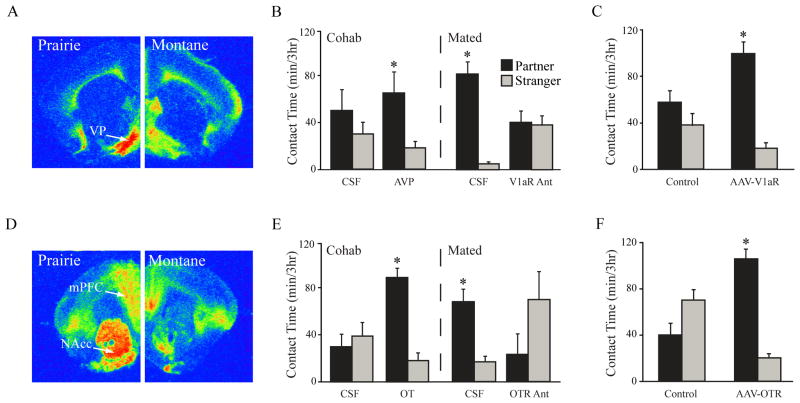Figure 2.
Vasopressin (AVP) and oxytocin (OT) regulation of partner preference formation. (A) Species differences in vasopressin receptor (V1aR) binding in the ventral pallidum (VP) of prairie and montane voles. Higher densities of receptors are indicated by more red coloration. (B) Site-specific manipulation of AVP neurotransmission in the lateral septum (LS) of male prairie voles. Data demonstrate that after 6 hours of non-sexual cohabitation with a female (Cohab), control males given LS injections of vehicle (cerebrospinalfluid; CSF) do not display partner preferences. However, AVP infusion into the LS induces partner preferences. Following 24 hours of cohabitation with mating (Mated), CSF treated control males display partner preferences. However, blockade of V1aRs, via infusion of a V1aR antagonist (V1aR Ant) into the LS inhibits the formation of mating-induced partner preferences. (C) Male prairie voles overexpressing the V1aR gene (AAV-V1aR) in the ventral pallidum display partner preferences after 17 hours of non-sexual cohabitation with females, whereas control males do not. (D) Species differences in oxytocin receptor (OTR) binding in the medial prefrontal cortex (mPFC) and nucleus accumbens (NAcc) of prairie and montane voles. (E) Site-specific manipulation of OT neurotransmission in the NAcc of female prairie voles. After 6 hours of non-sexual cohabitation with a male (Cohab), female prairie voles infused with OT in the NAcc display partner preferences, whereas control females infused with CSF do not. After 24 hours of cohabitation with mating (Mated), control females infused with CSF form partner preferences. However, intra-NAcc blockade of OTRs, via infusion of an OTR antagonist (OT Ant), inhibits the formation of mating-induced partner preferences. (F) Female prairie voles overexpressing the OTR (AAV-OTR) in the NAcc form partner preferences after less than 24 hours of mating and cohabitation with a male whereas control females do not. Bars indicate means ± standard error of the mean. *: p < 0.05. Adapted from [149, 150, 183, 188].

